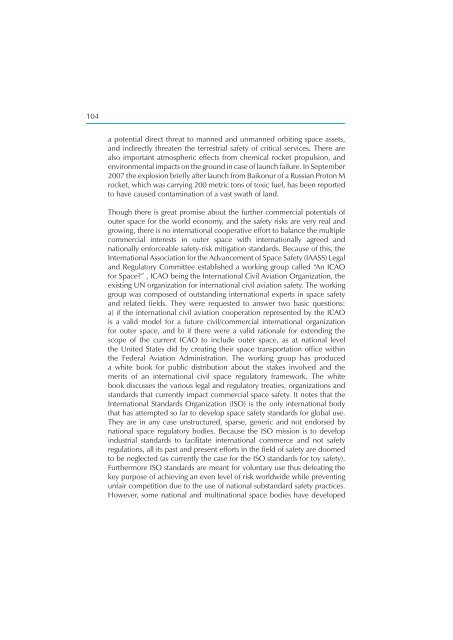Security in Space The Next Generation - UNIDIR
Security in Space The Next Generation - UNIDIR
Security in Space The Next Generation - UNIDIR
You also want an ePaper? Increase the reach of your titles
YUMPU automatically turns print PDFs into web optimized ePapers that Google loves.
104<br />
a potential direct threat to manned and unmanned orbit<strong>in</strong>g space assets,<br />
and <strong>in</strong>directly threaten the terrestrial safety of critical services. <strong>The</strong>re are<br />
also important atmospheric effects from chemical rocket propulsion, and<br />
environmental impacts on the ground <strong>in</strong> case of launch failure. In September<br />
2007 the explosion briefl y after launch from Baikonur of a Russian Proton M<br />
rocket, which was carry<strong>in</strong>g 200 metric tons of toxic fuel, has been reported<br />
to have caused contam<strong>in</strong>ation of a vast swath of land.<br />
Though there is great promise about the further commercial potentials of<br />
outer space for the world economy, and the safety risks are very real and<br />
grow<strong>in</strong>g, there is no <strong>in</strong>ternational cooperative effort to balance the multiple<br />
commercial <strong>in</strong>terests <strong>in</strong> outer space with <strong>in</strong>ternationally agreed and<br />
nationally enforceable safety-risk mitigation standards. Because of this, the<br />
International Association for the Advancement of <strong>Space</strong> Safety (IAASS) Legal<br />
and Regulatory Committee established a work<strong>in</strong>g group called “An ICAO<br />
for <strong>Space</strong>?” , ICAO be<strong>in</strong>g the International Civil Aviation Organization, the<br />
exist<strong>in</strong>g UN organization for <strong>in</strong>ternational civil aviation safety. <strong>The</strong> work<strong>in</strong>g<br />
group was composed of outstand<strong>in</strong>g <strong>in</strong>ternational experts <strong>in</strong> space safety<br />
and related fi elds. <strong>The</strong>y were requested to answer two basic questions:<br />
a) if the <strong>in</strong>ternational civil aviation cooperation represented by the ICAO<br />
is a valid model for a future civil/commercial <strong>in</strong>ternational organization<br />
for outer space, and b) if there were a valid rationale for extend<strong>in</strong>g the<br />
scope of the current ICAO to <strong>in</strong>clude outer space, as at national level<br />
the United States did by creat<strong>in</strong>g their space transportation offi ce with<strong>in</strong><br />
the Federal Aviation Adm<strong>in</strong>istration. <strong>The</strong> work<strong>in</strong>g group has produced<br />
a white book for public distribution about the stakes <strong>in</strong>volved and the<br />
merits of an <strong>in</strong>ternational civil space regulatory framework. <strong>The</strong> white<br />
book discusses the various legal and regulatory treaties, organizations and<br />
standards that currently impact commercial space safety. It notes that the<br />
International Standards Organization (ISO) is the only <strong>in</strong>ternational body<br />
that has attempted so far to develop space safety standards for global use.<br />
<strong>The</strong>y are <strong>in</strong> any case unstructured, sparse, generic and not endorsed by<br />
national space regulatory bodies. Because the ISO mission is to develop<br />
<strong>in</strong>dustrial standards to facilitate <strong>in</strong>ternational commerce and not safety<br />
regulations, all its past and present efforts <strong>in</strong> the fi eld of safety are doomed<br />
to be neglected (as currently the case for the ISO standards for toy safety).<br />
Furthermore ISO standards are meant for voluntary use thus defeat<strong>in</strong>g the<br />
key purpose of achiev<strong>in</strong>g an even level of risk worldwide while prevent<strong>in</strong>g<br />
unfair competition due to the use of national substandard safety practices.<br />
However, some national and mult<strong>in</strong>ational space bodies have developed








